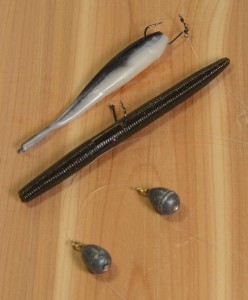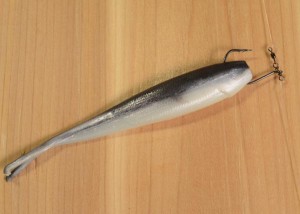
Drop shot rigs – Gary Yamamoto 5″ Yamasenko (Dark Pumpkin with Purple, Black and Emerald) on a Gamakatsu size 1 finesse wide gap hook. Berkley Gulp 4″ Minnow (Black Shad) on a size 1 Zero Twist (TM) Shot hook from Stringease.
Drop shotting is a finesse technique so a good setup is on a lighter, sensitive spinning rod and reel with 6-10 lb test line. Tie on your hook using a Palomar knot leaving a good length of extra line (18-24 inches). If you need a good explanation for this knot (or a huge variety of others) I highly recommend the “What Knot” App from Columbia Sportswear (free for iPhone – What Knot to do in the Great Outdoors). It contains illustrated step by step instructions for a huge variety of knots for fishing, boating and climbing.

Size 1 Zero Twist (TM) Shot hook from Stringease Tackle Mfg. Co. Ltd (www.stringease.com) with Berkley Gulp 4″ Minnow (Black Shad).
Cast to target and let sink while keeping enough slack out of the line to feel a strike. Let sink to the bottom. Still fish or slightly jiggle the bait without lifting the weight off the bottom. Maintain a taught line to feel any strike.
The drop shot rig is good for depths of 5 ft or deeper with more weight needed the deeper you go. For shallow water fishing (3-5 ft) its likely better to fish the type of plastics shown in the figures without a weight.



Pingback: Wildwood Lake Ice Fishing for Perch » The Scientific Fisherman